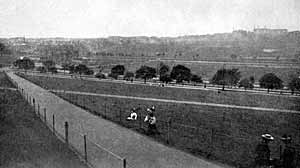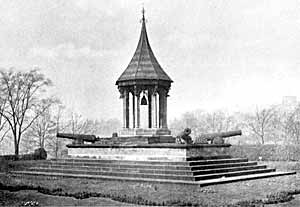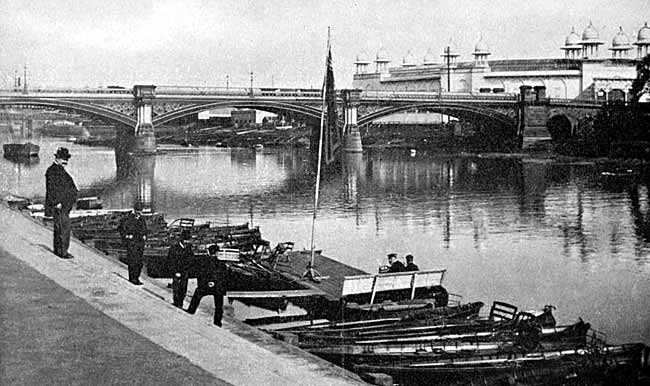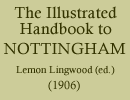< Previous | Contents | Next >
Chapter VIII.
Local celebrities, Nottingham trade and city governments. The parks.
Literary Men.
NOTTINGHAM and the neighbourhood have given birth to several men of eminence in Literature and Art. William Howitt, born at Heanor, just outside the county border, became Alderman of Nottingham, and resided there many years. Assisted by his wife, Mary Howitt, he wrote many works, the best known being Homes and Haunts of British Poets and the NorthernHeights of London. He died at Rome 1879, as did also Mary Howitt many years later. Philip James Bailey was born in the house before alluded to (p. 74), and, after many years of absence, returned to Nottingham to end his days, and died there at an advanced age in 1903. His best known poem, Festus, written when he was twenty-three (in the year 1839), was received with great favour. Henry Kirke White (see p. 42) was born in 1785, and after showing great promise as a poet, died at the premature age of twenty-one. He was part author of the well-known hymn, "Oft in danger, oft in woe," and has left to his native town the imperishable lines on Clifton Grove. Byron was born in London, but removed when ten years of age to his ancestral home of Newstead Abbey, ten miles from Nottingham. There is a tablet on a house in St. James' Street commemorating the fact that the poet inhabited it for two years during his boyhood. While his mother resided at Burgage Manor House, Southwell, Byron issued his first volume of verse, Fugitive Pieces, bearing the imprint S. & J. Ridge, Newark, 1806. The visitor should make a point of seeing Newstead Abbey, and Hucknall Torkard Parish Church, where Byron lies buried. There is a tablet on St. Nicholas' Rectory recording the birth of Gilbert Wakefield (1756-1801), an accomplished scholar and a keen, though incautious, controversialist. Robert Millhouse (1788-1839), of humble origin, published several volumes of poems, showing considerable natural talent.
Artists.
In Art also Nottingham has had, and fortunately still has, its representatives. Most people have heard of Paul Sandby, painter and etcher. He was born in Nottingham 1732, and died in London 1809, after receiving Royal patronage and the highest public honours. Thomas Sandby, brother of the above, also achieved fame and success as an architect and landscape gardener. Richard Parkes Bonington, born at Arnold, four miles from Nottingham, early obtained favourable notice as a painter, but died in 1801 at the early age of twenty-seven. Henry Dawson, the famous landscape painter, was born in Hull 1811, and came to Nottingham very early in life; he died near London 1878. This town was also the birthplace of Rossi, the sculptor (1763-1839).
Local Historians, Scientists, etc.
The principal local histories of the town and county have been written by Robert Thoroton, M.D. (who was born at Car Colston, and published his History of Notts 1677), Charles Deering, M.D., 1751, and John Blackner, 1815. Science is represented by John Russell Hind, the astronomer; Thomas Hawkesley, the water-engineer; and Marshall Hall, the physiologist.
Erasmus Darwin, M.D., who wrote several books, father of the author of The Origin of Species, was born at Elston, near Newark. Archbishop Cranmer was born at Aslockton, Notts. A future Archbishop of York, Richard Stern, father of the author of the Sentimental Journey, was born at Mansfield, and educated at the Nottingham High School.
Political Leaders.
Allusion has already been made (p. 76) to the prominent part Nottingham played during the Civil War, and several men of local origin have left well-remembered names. Among these we may mention General Ireton (Cromwell's son-in-law), who was born at Attenborough, five miles higher up the Trent than Nottingham. A house near the church is pointed out as his birthplace, and his name occurs in the Register. Gilbert Millington had an estate at Brinsley and Felley, and Greasley Church contains a monument to his memory. Major-General Whalley belonged to Screveton. These three all signed King Charles I.'s death warrant, as also did Colonel John Hutchinson. The last-named was born in Nottingham 1616, was educated at the High School (then the Grammar School) although his family belonged to Owthorpe, Notts, and after playing a prominent part in the defence of the town against the Royalists (see p. 76), died while imprisoned in Sandown Castle, Kent, 1664. There is a monument to his memory in Owthorpe Church, where he was buried.
Local Industries.
Some of the men whose names are held famous in this district have been connected with the rise and development of the local industries, the Lace and Hosiery Trades. The latter came first in point, of time, and it was in 1589 that the Rev. William Lee, Curate of Calverton, seven miles from Nottingham, invented the stocking-frame. Lee died a poor man, receiving no encouragement from Queen Elizabeth, who said his machine would ruin all her female subjects! The new invention only gradually made its way, being taken up first in London, afterwards in Nottingham and Leicester, the last-mentioned town in the end becoming the chief centre of the industry. The early attempts at lace-making by machinery were made by men at work on the stocking-frame. Two men, Richard Arkwright and Jedediah Strutt, who were partners in Nottingham in the latter part of the seveuteenth century, had a great deal to do with the future of the manufacture of silk and cotton goods. By them the "Spinning Jenny," invented by Hargreaves, who had a factory (said to have been the first ever erected) in Nottingham, was greatly improved. Strutt built the Belper Cotton Mills, and his grandson, Lord Helper, made Nottinghamshire his home, and erected a fine Elizabethan mansion at Kingston-on-Soar. Arkwright, after whom is named Arkwright Street, which runs between the Midland Railway Station and Trent Bridge, became owner of the Cromford Mills, and received the honour of knighthood. A Loughborough man, John Heathcote, made improvements in lace-making, and on the expiration of his patents in 1823, the greatest activity prevailed in the trade. Many "Luddite," or frame-breaking outrages occurred from 1811 to 1820. Jacquard in Lyons and Levers in Nottingham made valuable developments in lace machinery, and since their time the onward process has been continually in operation.
Lace and Hosiery Factories.
The visitor to Nottingham should, if possible, be shown over some of our large establishments where lace is manufactured, and also those where it is finished, made up, and "dressed." Hosiery hand-frames are now superseded by "rotary" machines, although in country districts round Nottingham a few hand-frames are still at work; this industry, becoming almost extinct, is assisted by Government orders. Nottingham has greatly suffered in recent years by the removal of machinery to villages in the neighbourhood and to Europe and America. The Lace Market, where the buying and selling of lace goes on, has been already referred to (p. 66).
The building of lace-machinery also forms one of the principal Nottingham industries. Other mechanical pursuits are not very widely practised, the most important being cycle and motor building, the "Humber" and the "Raleigh," being firms of more than local celebrity.
The Nottingham Corporation consists of sixteen Aldermen and forty-eight Councillors, from whom a Mayor and Sheriff are elected annually. Under the management of this public body are the University College, Free Library, Education, Castle Museum, the Gas, Water, Electricity, Police, and other departments. Not least of its functions is the care of the Public Health, which is greatly promoted by the provision of an excellent supply of water drawn from borings in the sandstone hills between Nottingham and Mansfield, and the efficient system of draining. The Electric Light service is admirable, and has not once failed since its first installation in 1893. The Tram Service is one of the best in Great Britain.

The Forest, looking towards New Basford.

The Chinese Bell, Arboretum.
The Public Parks and Recreation Grounds are all under Corporation management. The Arboretum, Elm Avenue, and Corporation Oaks have been already mentioned (pp. 53-54). The Forest is par excellence the playground of Nottingham, with its wide expanse of eighty acres, divided pretty equally between undulating grassy slopes and a level plain for the pursuit of cricket and football. The Races were held here until 1890, when they were removed to Colwick (see p. 111) On one side the Forest adjoins the Church Cemetery (for route see p. 34), and on the other is bounded by
The Gregory Boulevard.
A fine street laid out and planted by the town in 1881, now forming a straight avenue a mile long. It is continued by means of the Radford and Lenton Boulevards (along which a tram runs) around the foot of the Castle Rock to Carrington Street near the Midland Station (see p. 32).
Queen's Walk.
Just beyond the station we come to a neatly planted garden leading to another long shady avenue, known as Queen's Walk. The statue of Sir Robert Clifton (of Clifton Hall, and once Member for Nottingham) used to stand at the entrance to the walk, and is now removed to the Cattle Market, which is also in this distiict of the town. At the far end of Queen's Walk we come to Wilford Bridge (toll 1/2d, to 2d.), which leads to the charming villages of Clifton and Wilford (see pp. 110-111). Just above it is Clifton Colliery, reminding us that Nottingham is on the borders of the Great North Midland Coal Field, and spanning the river a little lower down is the viaduct of the Great Central Railway.
The Victoria Embankment Gardens have been recently laid out by the Corporation, and form a most pleasant place for walking or resting on the numerous seats overlooking the river. West Bridgford may now be expeditiously reached from the Gardens by the new, handsome Suspension Bridge. A walk of about half-a-mile will bring us to
Trent Bridge.
The elegant structure erected by the City Engineer, the late Mr. M. O. Tarbotton, in 1871, in place of the ancient stone bridge of fifteen arches, supported by heavy buttresses, the remains of which can still be seen adjoining the south bank. From the centre of the bridge beautiful views can be obtained both up and down stream. Numerous pleasure boats on hire are moored on the right bank, and just opposite is the Steamboat Pier and another small public garden.

Trent Bridge.
From Trent Bridge we may take a penny tram direct to the Market, along Arkwright Street, or may walk along the old London Road, passing the Cattle Market, the Eastcroft Sanitary Wharf, the London Road Railway Stations, all on our right hand. Continuing straight on we come to a steep hill where the rock is exposed at the sides. Here we turn to the left into Hollow Stone, which takes us into The Pavement, past St. Mary's Church (pp. 67-70), and so back to the Market Place. In addition to the Parks already mentioned, there are Recreation Grounds for Lenton, Radford, and Sneinton respectively. The Cemeteries at Basford and Bulwell are also under Municipal management.
